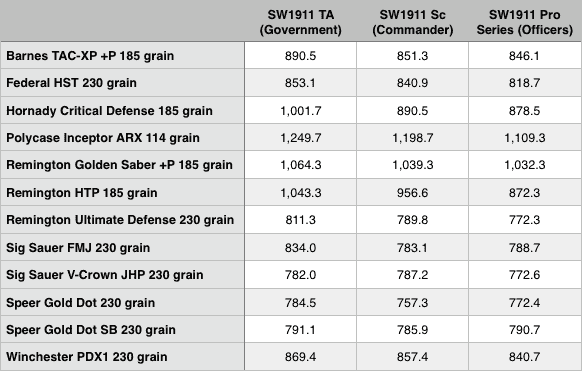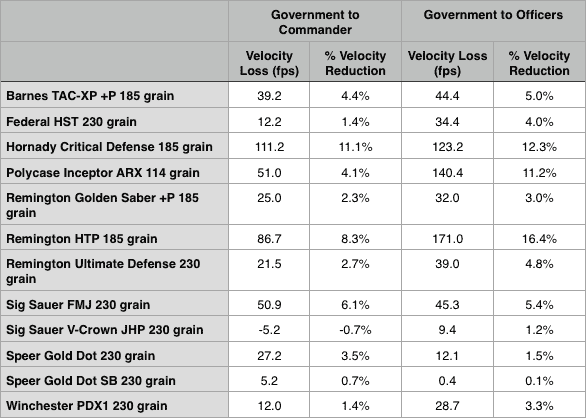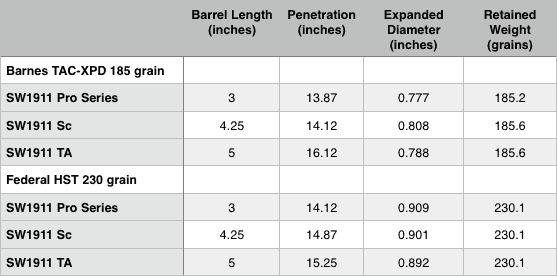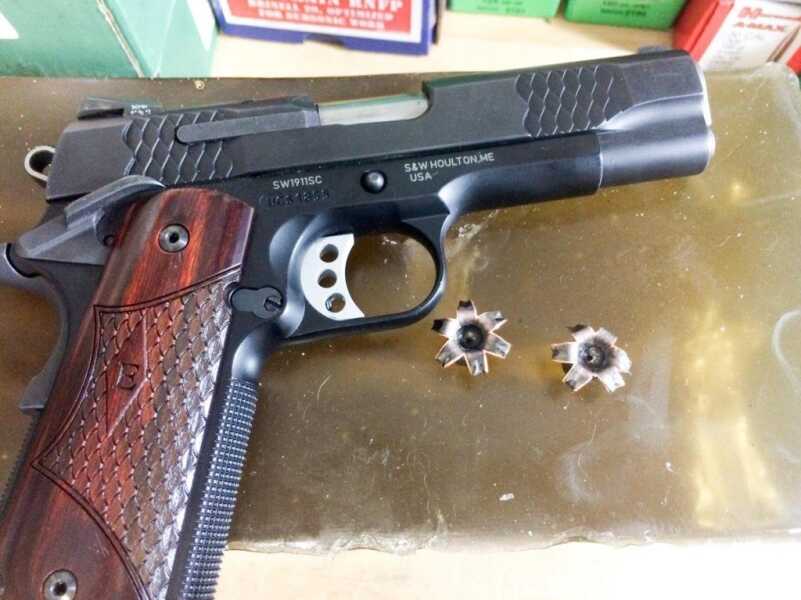I don’t know about you, but I tire rapidly from all the “opinion” battles we gun people have on the internet. You know, things like what’s better for pocket carry, 9mm or .600 Nitro Express? Given what I do for a living, sometimes I can finagle a project where I actually test the subjects of these debates, just to get a handle on what information is legit and what’s not.
One that folks argue involves the ballistic tradeoffs between the various sizes of 1911 pistols. On paper, there are three types of 1911 handguns: Government, Commander, and Officer models. While every manufacturer takes liberties on exact dimensions, those classes basically boil down to 5-inch, 4.25-inch, and 3.5-inch barrels.
The question of the real impact of barrel length comes up frequently, so I decided to do some ballistic measurement from all three classes. You know, look at things like velocity and performance in gelatin from all three types of pistols to see if there are really significant differences.
I rounded up three different 1911 pistols, all from Smith & Wesson. I figured this would minimize variables like barrel construction and type of rifling. Besides, they were nice enough to loan these guns for this article.
This eSeries model is a Government model complete with a five-inch barrel. It’s got a rail, but for purposes of ballistic testing, that’s irrelevant.
This model is the Scandium lighter-weight carry mode. It’s got a 4.25-inch barrel. It’s optimized for concealed carry due to the lighter weight and rounded butt profile. For ballistic purposes, though, it’s a classic representation of the Commander class.
Smith & Wesson SW1911 Pro Series
I chose this compact model to represent the Officer model class even though it has a three-inch barrel. The original Colt Officers model actually had a 3.5-inch barrel, but I figured dropping all the way to a three-inch model would be more enlightening since we’re looking at velocity differences and potential performance impacts on expansion and penetration.
Velocity
The first step in the process was to measure the velocity of a variety of .45 ACP ammo types and bullet weights. I set up my trusty Shooting Chrony Beta Master Chronograph, which has only been shot to pieces a few times, 15-feet down range. For each of the ammo types below, I fired strings from each of the three pistols and calculated the average velocity for each specific pistol and ammunition combination.
The reason for all this was to see exactly how the shorter barrel lengths of the Commander and “close enough” Officers models would impact velocity. Really rough rules of thumb might indicate that you lose 30 to 50 feet per second for each one-inch reduction in barrel length, but that depends on a million variables too.
Here’s what I found.

The table above represents the raw numbers based on the average velocity of each combination. To enable data digestion with less heartburn, I did some math to create a chart that shows the actual velocity reduction numbers and percentages for two matchups: The Government SW1911 eSeries compared to the Commander SW1911 Sc and the Government SW1911 TA compared to the “Officers” SW1911 Pro Series.

The first thing you’ll notice is that when it comes to shooting bullets, nothing is entirely predictable. If you did the math before shooting, you might suspect that the .75-inch shorter barrel of the SW1911 Sc compared to the SW1911 TA might give you an across the board velocity reduction of 30 feet per second, give or take. Similarly, you might think the two-inch barrel length reduction between the SW1911 TA and SW1911 Pro Series would yield a standard 80 feet per second reduction in velocity.
In actuality, while there was a huge variance in velocity reduction from load to load, the average of the loss was in fact 36.4 percent. The average percentage velocity reduction worked out to 3.8 percent. Those numbers include the anomaly of the Sig Sauer V-Crown JHP 230-grain load actually clocking a few feet per second faster from the 4.25-inch SW1911 Sc. Hey, strange things happen. Powder burn rate, the material of the bullet jacket, and effects of that extra .75 inches of friction can do strange things.
When looking at the velocity differences between the five-inch barreled SW1911 TA and three-inch barreled SW1911 Pro Series, the overall velocity reduction was also consistent. When you average all the loads tested, velocity was 56.7 feet per second lower from the three-inch gun. Again, as you can see, there was pretty wide variance from load to load.
On thing that was interesting was the relatively consistent velocity readings from the Speer Gold Dot ammo. Th difference in velocity from the five-inch gun, the 4.25-inch gun, and the three-inch gun was statistically zero. I can’t say for certain why this is, but my theory is that the softer total metal jacket construction of Gold Dot bullets is less sensitive to barrel friction. But that’s just a guess.
Also, while we’re talking about Speer Gold Dot ammo, you’ll see I fired the Short Barrel 230-grain load from the Government model and the Commander. In real life, this load is designed for guns with barrel lengths of 3.5-inches or less, but I wanted to see the velocity difference. Normally, you would expect much higher velocity from the longer barrel guns, which would increase the risk of over-expansion and under penetration. In this particular case, as the velocities were about the same, I wouldn’t expect any ill effect from using the SB in the larger guns.
Shooting Jello with Big, Medium and Small Guns
The whole point of doing all that velocity testing is that modern self-defense ammunition is designed to perform within a relatively narrow band of speed. To achieve perfect expansion and deep enough penetration, every particular bullet design requires a specific velocity to meet those goals. And by “particular bullet design” I don’t mean brands. I mean each and every bullet, caliber, and weight variety is designed to open up at different rates based on its anticipated velocity. A 230-grain .45 ACP Barnes TAC bullet has to expand easily at 850 feet per second while a 1,200 feet per second 124-grain 9mm Barnes TAC projectile will be designed to expand less easily because it’s moving a lot faster.
To get a hint at how the different barrel lengths of these guns might (or might not) impact expansion and penetration performance, I picked two of the loads and fired several rounds of each into Clear Ballistics gelatin blocks from each of the three guns.
This load uses the Barnes TAC all copper projectile. In a wide variety of calibers and bullet weights, I’ve found this bullet design to perform consistently, hence the choice here.
This one worked perfectly as well, with all three pistol sizes, but exhibited an interesting behavior. About half of the rounds “bounced back” a couple of inches in the wound track. If the wound track was 15 inches long, I might have pulled the bullet out of the gel at a distance of 12 inches. I figure it was some elasticity in the gel block pushing the projectile back at the end of it’s forward travel. No worries, though, the bullets did everything they were supposed to.
After the jello blocks abuse session, I calculated averages of penetration, bullet expansion, and retained bullet weight for each of the two ammo types fired from all three guns.

You might notice that there are a couple of examples where the smaller gun obtained greater expansion results. This is actually normal and expected. With higher velocity, the petals on the bullets expand to maximum diameter while penetrating the gel, and then keep going, so the petals end up bent a little bit backward towards the base. While this results in a smaller ending diameter, you have to remember that the projectile already reached maximum diameter during its travel.

The Commander-sized SW1911 Sc generated excellent expansion and penetration results with both the Barnes TAC-XPD ammo (shown) and the Federal HST.
As expected, more velocity resulted in deeper penetration with both of these loads so you might say the full-sized Government model performed a little better. Whether that’s practically relevant is a different question. Standard FBI test protocols require 12 to 18 inches and all of the combinations tested reached that standard.
Recoil
The recoil you feel depends on a lot of things. The raw energy measurement of recoil is based on the weight of the bullet itself, the weight of the powder charge, and the velocity of the projectile and burned gas. The design of the gun, revolver or semi-automatic comes into play also as semi-automatic pistols redirect energy into the operation of the gun. As a result, a semi-auto usually feels like it has less recoil than the same caliber fired from a fixed breech gun. The weight of the gun also comes into play. These three pistols range from the all-steel mac daddy Government to lightweight carry models, so I wanted to quantify some of the recoil differences.
Just to provide a rough reference of the energy differences, I did a little recoil math. Remember the numbers vary with each and every cartridge, so I chose one of my .45 ACP hand loads as the constant ammo selection since I know the weight of the powder charge inside. That load uses 7.2 grains of powder and a 230-grain projectile.

As expected, you pay a price in terms of felt recoil when moving to the smaller and more concealable Commander and Officer sizes. The reduced weight of these smaller guns is the primary cause, although the lower velocity of the bullet and gasses leaving the muzzle provide some help in the opposite direction. The shorter barrel means less velocity, which translates to a little less recoil.
The Net-Net
So what does all this mean? Getting into a little bit of conjecture, I think the slow and heavy nature of the .45 ACP caliber works to advantage here. There’s a relatively small loss of velocity as you move down to smaller guns with shorter barrels. As .45 ACP projectiles are designed to expand at more moderate velocities anyway, the slight reductions in speed didn’t have a big impact on terminal performance. With the lighter 185-grain bullet, we gave up about two inches of penetration, but the results were still in an acceptable territory. The heavier 230-grain projectile only gave up just over one-inch of penetration.
Bottom line? In this particular case of a 1911 shooting .45 ACP ammo, you’ll endure more recoil as the price of moving to a smaller carry gun, but terminal performance won’t suffer a huge hit.





Thanks a bunch for the succinct summary. This is the perfect answer to my little questions.
Curious how the Pro series did reliability wise. Did you have any failures of any kind with the JHP ammo?
Very helpful and interesting!
I often wondered how much velocity was lost with my g30 over a 21 or 41.
With this info I worry less not that I was real worried to begin with
I wonder how the Para Ordinance “WART HOG” would fare in these tests. I can say that recoil is significant.
Great study project! Imagine the fun factor. I have full lengths and a commander length, and am adding your result to my archives.
Great piece, useful and practical info.
Great article, no b.s., just the facts ma’am. I have a 5in Kimber, 4.25in S&W and a 3in Kimber that I have shot many handloads over a CE chrono and noticed the same thing. Some times certain loads shoot about the same speed out of the 5in & 4.25in barrels, but always a little slower out of the 3in. My 3in Kimber is an Ultra CDP and only weights 25oz,which makes for a great carry gun, but it is a little “snappy” but still very controllable. In response to Todds coment on not using a 3.5in barrel, most compact 1911s in 45 that I have seen are 3in. Thanks again for a great article!
Nice. Well written and no B.S. I especially like the HST photos. I’ve been using Hydra-shoks since they came out back in the eighties but have been thinking of trying the 230 grain HST. Think I’ll order some and do some testing of my own.
Thanks for sharing.
Excellent article! Also a good eye opener! I’d love to have one of those Series E’s. That is a beautiful pistol!
Good article, and well thought out. I carried a Colt 1911 on duty, and had worked my way up to it…hollow points were basically not available for it, though Lee Jurras, if I have his name right, had come out with Super Vel bullets for reloading. I had wondered a million times, about the effectiveness of a lighter, shorter barrel. BTW…I found that shooting my pistol loads through the Thompson SMG produced way better results, due no doubt to the longer barrel. THAT would be an interesting comparison article too, perhaps…in all comparable M&P calibers, pistols vs. smg’s.
Anyway…thanks for the nice article, and pics. I’ll have to contact Smith about their little 3″ barreled wonder.
Tom Fowler
I was a little surprised by how low some of the velocities were even from the government size model. But my main concern is this entire test involved ballistic gelatin. Almost everything expands wonderfully impure ballistic gelatin. I know the purpose of your test was to check velocities primarily. But human beings are not naked bags of water with no bones inside. I have done many tasks using a leather coat folded so that makes four layers of leather and some insulation. Two layers of denim. They didn’t have access to auto glass. Sheet metal yes. No round that I ever tried that has come out since the Speer Gold Dot has performed has consistently as the Golddot. Nobody has built the bullet to surpass it. For 45 ACP fans 200 gr @ 10000 G.D.!!!!
You are dead on. Introducing barriers can make a lot of difference. Too many variables for the scope of this test, so I focused more on the penetration aspect. I’ve seen similar things when shooting through denim and especially leather. Good bullets may or may not expand properly and consistently when these barriers are introduced. Always a good idea to test your choice of carry ammo through clothing barriers and into a pile of wet newspaper if gelatin isn’t available. It’s a pain to do, but very enlightening.
Great article. Now we need the same done for the 9mm cartridge. 9mm 1911s are gaining in popularity and the higher velocity of the 9mm Luger cartridge compared to the .45 ACP would make the results very interesting.
Excellent suggestion, I’ll check with the editorships on this for a future topic 🙂
,45 cal in P+ verses 9 mm P+ would be a nice comparison
Would you prefer the fat heavy knock down power of 185 grains of hollow point
Or the hard hitting deep penetration of the 115 grain load
I’m leaning toward the .45 myself but either one should do the trick.
It all just goes to show you no matter which model you prefer (mine is a Springfield Armory 1911 A-1) inside twenty five yards the job gets done !!
Great article. I would be interested in your perception of the recoil. Did the “feel” line up with the math?
As best as I could “feel” subjectively, it did line up with the math. The small Pro Series had noticeably more recoil than the heavy Govt, but in my opinion, nothing like that of a compact .40 S&W caliber. Maybe because the .45 ACP is more of a “push” than a “snap” but I found the recoil in the smallest one very manageable.
Up in the article, under the photo of the six expanded Federal HSTs on ballistic gelatin, it says they are “23 grain” – I think you dropped the zero, and it should be “230 grain”.
Doh!
I see you made the correction. =)
How about a all steel 3 in.compared to the 5 in?
Good article……… but why use a 3″ when the majority of Officers 1911’s are 3.5″?
We get to see true gov. & commander specs, Why not show us the true Officer’s length results. it seems you were more interested in getting bigger spread numbers and went with a 3″ to see them. completely ignoring the 3.5″ even though it is the size the majority of us have. I’m sure the 3″ 1911 people are happy to see these, All 5 of them!. now, how about specs for the real Officer’s size 1911? so the majority of us have something to look at. I’m sure smith could have loaned you 4 guns instead of 3, if your going to have a 1911 comparison, and you only get 3 guns, you should use the 3 standard sizes.!
if you did a car top speed review, would you pick a Ferrari, a Porsche, and a vw beetle?
interesting to say the least.
I have the full sized polymer framed kimber polymer target for my CCW (it helps to have a beer gut!).
5 inch barrel. The weight of my plastic kimber vs my steel colt gov’t model is 2 oz less even though I have 15 rounds of 45 vs 8 rounds in the colt.
Looks like I’ll be buying the Federal HST bullets. I’ve been carrying remington golden sabre as that is what the local P.D. carries.
I wish you would have said what kind of powder it was. I’m guessing Unique due to the weight of 7.2 grains.
Wow you sure are projecting a lot of conspiracy theory into this relatively straightforward comparison… Instead of getting all cranked up over nothing you could also split the difference between the 3-inch and 4.25-inch results.
Great article, very well written. I prefer the compact officers model for ease of concealment. As far as ballistics go, if I ever had to use it for self defense I don’t expect to have to shoot more than 4-6 feet, so the loss in velocity is not a big deal for me.
Great article! Kept the variables to an absolute minimum, and “please mam, just the facts” attitude. I wish everybody could do their comparisons as well.
Great comparison. I archived a copy of your tables for my future reference. Sometimes these comparisons turn out to be a search for the next decimal place but this one made sense to me. My prior impressions of shorter barreled 1911s, in terms of terminal performance, were a simply unfounded.
EXECELLENT ARTICLE.